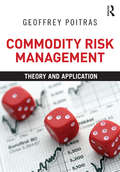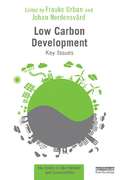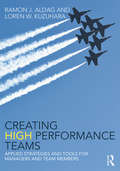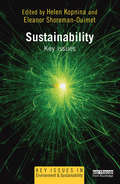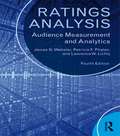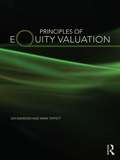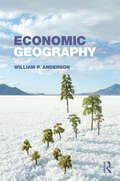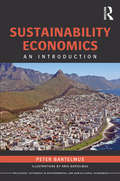- Table View
- List View
Commodity Risk Management: Theory and Application
by Geoffrey PoitrasCommodity Risk Management goes beyond just an introductory treatment of derivative securities, dealing with more advanced topics and approaching the subject matter from a unique perspective. At its core lies the concept that commodity risk management decisions require an in-depth understanding of speculative strategies, and vice versa. The book offers readers a unified treatment of important concepts and techniques that are useful in applying derivative securities in the management of risk in commodity markets. While some of these techniques are well known and fairly common, Poitras offers applications to specific situations and links to speculative trading strategies - extensions of the material that not only are hard to come by, but helpful to both the academic and the practitioner. The book is divided into three parts. The first part deals with the general framework for commodity risk management, the second part focuses on the use of derivative security contracts in commodity risk management, and the third part deals with applications to three specific situations. As a textbook, this book is designed to appeal to classes at a senior undergraduate/MBA/MA levelof training in Finance, financial economics, actuarial science, management science, agriculturaleconomics and accounting. There will also be interest for the book as: a monograph for research libraries, a handbook for individuals working in the commodity risk management industry, and a guidebook for those in the general public interested in topics like farm risk management or the assessment of hedging practices of publicly-traded commodity producers.
International Organizational Behavior: Transcending Borders and Cultures
by Dean McFarlin Paul SweeneyIn today’s increasingly diverse, multicultural business world, managers and employees alike need to transcend many borders (literally or figuratively) and grasp a wide variety of cultural nuances on a routine basis. Doing this well requires both a sophisticated understanding of cultural differences as well as a repertoire of skills and management tactics that can be brought to bear to build and maintain a competitive global workforce. International Organizational Behavior focuses on understanding and managing organizational behavior in an international context, providing both the conceptual framework needed for a transcendent understanding of culture along with plenty of practical advice for managing international challenges with organizational behavior.
International Organizational Behavior: Transcending Borders and Cultures
by Dean McFarlin Paul SweeneyIn today’s increasingly diverse, multicultural business world, managers and employees alike need to transcend many borders (literally or figuratively) and grasp a wide variety of cultural nuances on a routine basis. Doing this well requires both a sophisticated understanding of cultural differences as well as a repertoire of skills and management tactics that can be brought to bear to build and maintain a competitive global workforce. International Organizational Behavior focuses on understanding and managing organizational behavior in an international context, providing both the conceptual framework needed for a transcendent understanding of culture along with plenty of practical advice for managing international challenges with organizational behavior.
Low Carbon Development: Key Issues
by Frauke Urban Johan NordensvardLow Carbon Development: Key Issues is the first comprehensive textbook to address the interface between international development and climate change in a carbon constrained world. It discusses the key conceptual, empirical and policy-related issues of low carbon development and takes an international and interdisciplinary approach to the subject by drawing on insights from across the natural sciences and social sciences whilst embedding the discussion in a global context. The first part explores the concept of low carbon development and explains the need for low carbon development in a carbon constrained world. The book then discusses the key issues of socio-economic, political and technological nature for low carbon development, exploring topics such as the political economy, social justice, financing and carbon markets, and technologies and innovation for low carbon development. This is followed by key issues for low carbon development in policy and practice, which is presented based on cross-cutting issues such as low carbon energy, forestry, agriculture and transportation. Afterwards, practical case studies are discussed from low carbon development in low income countries in Africa, middle income countries in Asia and Latin America and high income countries in Europe and North America. Written by an international team of leading academics and practitioners in the field of low carbon development, this book is essential reading for students, academics, professionals and policy-makers interested in the fields of low carbon development, climate change mitigation, climate policy, climate change and development, global environmental change, and environment and development.
Low Carbon Development: Key Issues
by Frauke Urban Johan NordensvardLow Carbon Development: Key Issues is the first comprehensive textbook to address the interface between international development and climate change in a carbon constrained world. It discusses the key conceptual, empirical and policy-related issues of low carbon development and takes an international and interdisciplinary approach to the subject by drawing on insights from across the natural sciences and social sciences whilst embedding the discussion in a global context. The first part explores the concept of low carbon development and explains the need for low carbon development in a carbon constrained world. The book then discusses the key issues of socio-economic, political and technological nature for low carbon development, exploring topics such as the political economy, social justice, financing and carbon markets, and technologies and innovation for low carbon development. This is followed by key issues for low carbon development in policy and practice, which is presented based on cross-cutting issues such as low carbon energy, forestry, agriculture and transportation. Afterwards, practical case studies are discussed from low carbon development in low income countries in Africa, middle income countries in Asia and Latin America and high income countries in Europe and North America. Written by an international team of leading academics and practitioners in the field of low carbon development, this book is essential reading for students, academics, professionals and policy-makers interested in the fields of low carbon development, climate change mitigation, climate policy, climate change and development, global environmental change, and environment and development.
Leveraging Brands in Sport Business
by Mark P. Pritchard Jeffrey L. StinsonThis edited text compiles advanced material relating to strategy and marketing in the field of sports business. Featuring contributions from experts across the sports business field, the book approaches strategy from the standpoint of managing and marketing a brand. With integrated current-day examples highlighting practices and issues, as well as ‘real-world’ applied video cases, this book is ideal for marketing students and sports business practitioners looking to gain strategic insights into the industry.
Leveraging Brands in Sport Business
by Mark P. Pritchard Jeffrey L. StinsonThis edited text compiles advanced material relating to strategy and marketing in the field of sports business. Featuring contributions from experts across the sports business field, the book approaches strategy from the standpoint of managing and marketing a brand. With integrated current-day examples highlighting practices and issues, as well as ‘real-world’ applied video cases, this book is ideal for marketing students and sports business practitioners looking to gain strategic insights into the industry.
Creating High Performance Teams: Applied Strategies and Tools for Managers and Team Members
by Ray Aldag Loren KuzuharaCreating High Performance Teams is an accessible and thorough new introduction to this key area of business education. Written by teams experts Ray Aldag and Loren Kuzuhara, this book provides students with both a firm grounding in the key concepts of the field and the practical tools to become successful team managers and members. Built on a solid foundation of the most up to date research and theory, chapters are packed with case studies, real-world examples, tasks and discussion questions, while a companion website supports the book with a wealth of useful resources for students, team members, and instructors. Centered around an original model for high performance teams, topics covered include: Building and developing effective teams Managing diversity Effective communication Team processes – meetings, performance management Dealing with change and team problems Current issues – virtual teams, globalization With its combined emphasis on principles and application, interwoven with the tools, topics, and teams most relevant today, Creating High Performance Teams is perfectly placed to equip upper-level undergraduate and MBA students with the knowledge and skills necessary to take on teams in any situation.
Sustainability: Key Issues (Key Issues in Environment and Sustainability)
by Eleanor Shoreman-Ouimet Helen KopninaSustainability: Key Issues is a comprehensive introductory textbook for undergraduate and postgraduate students doing courses in sustainability. Highly original, it covers the very broad spectrum of ideas covered under sustainability, from participation, resilience, growth, ecological modernism through to culture, sustainable communities and sustainable consumption. Each chapter covers one key idea, and has been written by an expert in that field. This book makes key issues approachable, with each chapter containing: a definition of the key concept a history of how and why the issue has emerged a discussion of the advantages, drawbacks, main contributions and controversies associated with this issue case studies to demonstrate how it works in reality critical discussion of mainstream models of sustainability and the reason why they don't work introduction of beyond-the-convention alternatives, including circular economy and cradle to cradle approaches This is the ideal book for students and anyone interested in understanding the key issues within sustainability and how they interact.
Ratings Analysis: Audience Measurement and Analytics
by James Webster Patricia Phalen Lawrence LichtyThis 4th edition of Ratings Analysis describes and explains the current audience information system that supports economic exchange in both traditional and evolving electronic media markets. Responding to the major changes in electronic media distribution and audience research in recent years, Ratings Analysis provides a thoroughly updated presentation of the ratings industry and analysis processes. It serves as a practical guide for conducting audience research, offering readers the tools for becoming informed and discriminating consumers of audience information. This updated edition covers: International markets, reflecting the growth in audience research businesses with the expansion of advertising into new markets such as China. Emerging technologies, reflecting the ever increasing ways to deliver advertising electronically and through new channels (social media, Hulu) Illustrates applications of audience research in advertising, programming, financial analysis, and social policy; Describes audience research data and summarizes the history of audience measurement, the research methods most often used, and the kinds of ratings research products currently available; and Discusses the analysis of audience data by offering a framework within which to understand mass media audiences and by focusing specifically to the analysis of ratings data. Appropriate for all readers needing an in-depth understanding of audience research, including those working in advertising, electronic media, and related industries, Ratings Analysis also has much to offer academics and policy makers as well as students of mass media.
Ratings Analysis: Audience Measurement and Analytics
by James Webster Patricia Phalen Lawrence LichtyThis 4th edition of Ratings Analysis describes and explains the current audience information system that supports economic exchange in both traditional and evolving electronic media markets. Responding to the major changes in electronic media distribution and audience research in recent years, Ratings Analysis provides a thoroughly updated presentation of the ratings industry and analysis processes. It serves as a practical guide for conducting audience research, offering readers the tools for becoming informed and discriminating consumers of audience information. This updated edition covers: International markets, reflecting the growth in audience research businesses with the expansion of advertising into new markets such as China. Emerging technologies, reflecting the ever increasing ways to deliver advertising electronically and through new channels (social media, Hulu) Illustrates applications of audience research in advertising, programming, financial analysis, and social policy; Describes audience research data and summarizes the history of audience measurement, the research methods most often used, and the kinds of ratings research products currently available; and Discusses the analysis of audience data by offering a framework within which to understand mass media audiences and by focusing specifically to the analysis of ratings data. Appropriate for all readers needing an in-depth understanding of audience research, including those working in advertising, electronic media, and related industries, Ratings Analysis also has much to offer academics and policy makers as well as students of mass media.
Principles of Equity Valuation
by Ian Davidson Mark TippettThe book provides a rigorous introduction to corporate finance and the valuation of equity. The first half of the book covers much of the received theory in these areas such as the relationship between the risk of an equity security and the return one can expect from it, the effects of leverage (that is, the borrowing policies of the firm) on the return one can expect from the firm’s shares and the role that dividends, operating cash flows and accounting earnings play in the valuation of equity. The second half of the book is more advanced and deals with the important role that "real options" (that is, as yet unexploited investment opportunities) play in the valuation of equity.
Principles of Equity Valuation
by Ian Davidson Mark TippettThe book provides a rigorous introduction to corporate finance and the valuation of equity. The first half of the book covers much of the received theory in these areas such as the relationship between the risk of an equity security and the return one can expect from it, the effects of leverage (that is, the borrowing policies of the firm) on the return one can expect from the firm’s shares and the role that dividends, operating cash flows and accounting earnings play in the valuation of equity. The second half of the book is more advanced and deals with the important role that "real options" (that is, as yet unexploited investment opportunities) play in the valuation of equity.
Water Security: Principles, Perspectives and Practices
by Bruce Lankford Karen Bakker Mark Zeitoun Declan ConwayThe purpose of this book is to present an overview of the latest research, policy, practitioner, academic and international thinking on water security—an issue that, like water governance a few years ago, has developed much policy awareness and momentum with a wide range of stakeholders. As a concept it is open to multiple interpretations, and the authors here set out the various approaches to the topic from different perspectives. Key themes addressed include: Water security as a foreign policy issue The interconnected variables of water, food, and human security Dimensions other than military and international relations concerns around water security Water security theory and methods, tools and audits. The book is loosely based on a masters level degree plus a short professional course on water security both given at the University of East Anglia, delivered by international authorities on their subjects. It should serve as an introductory textbook as well as be of value to professionals, NGOs, and policy-makers.
Water Security: Principles, Perspectives and Practices
by Bruce Lankford Karen Bakker Mark Zeitoun Declan ConwayThe purpose of this book is to present an overview of the latest research, policy, practitioner, academic and international thinking on water security—an issue that, like water governance a few years ago, has developed much policy awareness and momentum with a wide range of stakeholders. As a concept it is open to multiple interpretations, and the authors here set out the various approaches to the topic from different perspectives. Key themes addressed include: Water security as a foreign policy issue The interconnected variables of water, food, and human security Dimensions other than military and international relations concerns around water security Water security theory and methods, tools and audits. The book is loosely based on a masters level degree plus a short professional course on water security both given at the University of East Anglia, delivered by international authorities on their subjects. It should serve as an introductory textbook as well as be of value to professionals, NGOs, and policy-makers.
Event Sponsorship
by Ian McDonnell Malcolm MoirThis introduction to Event Sponsorship provides students with an essential understanding of the important role of sponsorship in an event, how this can be gained and successfully managed to the benefit of both the sponsor and sponsee. The text starts with an investigation of the origins of sponsorship and then considers all important elements of Events sponsorship management. It considers what sponsorship is, its history and evolution, what its marketing uses are, how it can used efficiently; the benefits it can bring to an event; and how its results can be measured. It also considers other funding sources for events including government grants, crowd source funding and merchandising. To reflect changes in the way firms communicate with their customers, there is a strong focus on the use of social media, e – marketing and technology in sponsorship. The text uniquely considers topics of sponsorship from perspective of both the sponsor and the sponsee (the event) to provide a holistic view of the sponsorship process. Case Studies are integrated throughout to show how both small and large scale events have successfully gained and used sponsorship as well as potential pitfalls to avoid. Learning outcomes, discussion questions and further reading suggestions are included to aid navigation throughout the book, spur critical thinking and further students’ knowledge. This is essential reading for all students studying Events Management.
Event Sponsorship
by Ian McDonnell Malcolm MoirThis introduction to Event Sponsorship provides students with an essential understanding of the important role of sponsorship in an event, how this can be gained and successfully managed to the benefit of both the sponsor and sponsee. The text starts with an investigation of the origins of sponsorship and then considers all important elements of Events sponsorship management. It considers what sponsorship is, its history and evolution, what its marketing uses are, how it can used efficiently; the benefits it can bring to an event; and how its results can be measured. It also considers other funding sources for events including government grants, crowd source funding and merchandising. To reflect changes in the way firms communicate with their customers, there is a strong focus on the use of social media, e – marketing and technology in sponsorship. The text uniquely considers topics of sponsorship from perspective of both the sponsor and the sponsee (the event) to provide a holistic view of the sponsorship process. Case Studies are integrated throughout to show how both small and large scale events have successfully gained and used sponsorship as well as potential pitfalls to avoid. Learning outcomes, discussion questions and further reading suggestions are included to aid navigation throughout the book, spur critical thinking and further students’ knowledge. This is essential reading for all students studying Events Management.
The Regulation of International Trade: 4th Edition
by Michael Trebilcock Robert Howse Antonia EliasonDrawing on a wide variety of classic and contemporary sources, respected authors Trebilcock and Howse here provide a critical analysis of the institutions and agreements that have shaped international trade rules. In light of the growing debate over globalization, they include special sections examinations of topics such as: * agriculture* services and trade-related intellectual property rights* labor rights* the environment* migration.*competition Drawing on previous highly praised editions, this comprehensive text is an invaluable guide to students of economics, law, politics and international relations. Now fully updated, this fourth edition includes full coverage of new developments including the Doha trade round, the proliferation of preferential trade agreements, the debate on trade, climate change and green energy, the response of the trading system to the 2007-2010 financial and economic crisis, the controversy over trade and exchange rate manipulation, and the growing body of WTO dispute resolution case law.
Economic Geography
by William P. AndersonEconomic geographers study and attempt to explain the spatial configuration of economic activities, including the production of goods and services, their transfer from one economic agent to another and their transformation into utility by consumers. The spatial configuration, which includes both the pattern of activities on the map and the relationships between activities occurring in different places, is the outcome of a vast number of distinct but interrelated decisions made by firms, households, governments and a variety of other private and public institutions. The goal of this book is to provide the student with a rigorous introduction to a diverse but logically consistent set of analytical models of the spatial decisions and interactions that drive the evolution of the economic landscape. It begins by explaining fundamental concepts that are critical to all topics in economic geography: the friction of distance, agglomeration, spatial interaction, market mechanisms, natural resources and production technologies. Sections follow to cover major areas of inquiry including multiregional economies, location theory, markets for space and systems of cities. The final section synthesizes and builds on these topics to address two trends that provide particular challenges to economic geographers today: globalization and the emergence of the knowledge economy.
Economic Geography
by William P. AndersonEconomic geographers study and attempt to explain the spatial configuration of economic activities, including the production of goods and services, their transfer from one economic agent to another and their transformation into utility by consumers. The spatial configuration, which includes both the pattern of activities on the map and the relationships between activities occurring in different places, is the outcome of a vast number of distinct but interrelated decisions made by firms, households, governments and a variety of other private and public institutions. The goal of this book is to provide the student with a rigorous introduction to a diverse but logically consistent set of analytical models of the spatial decisions and interactions that drive the evolution of the economic landscape. It begins by explaining fundamental concepts that are critical to all topics in economic geography: the friction of distance, agglomeration, spatial interaction, market mechanisms, natural resources and production technologies. Sections follow to cover major areas of inquiry including multiregional economies, location theory, markets for space and systems of cities. The final section synthesizes and builds on these topics to address two trends that provide particular challenges to economic geographers today: globalization and the emergence of the knowledge economy.
Strategic Management in the Arts
by Lidia VarbanovaStrategic Management in the Arts looks at the unique characteristics of organisations in the arts and culture sector and shows readers how to tailor a strategic plan to help these diverse organizations meet their objectives. Strategic management is an essential element that drives an organisation’s success, yet many cultural organizations have yet to apply strategic thinking and entrepreneurial actions within the management function. Varbanova reviews the existing theories and models of strategic management and then relates these specifically to cultural organisations. Also included are sections on entrepreneurship and innovations in the arts, considering the concept of a ‘learning organisation’ – an organisation able to adapt its strategy within a constantly changing, complex environment. The book is structured to walk the reader through each element of the strategic plan systematically. With a fresh approach, key questions, examples, international cases to connect theory with practice and suggestions for further reading, this book is designed to accompany classes on strategic planning, cultural management or arts management.
Strategic Management in the Arts
by Lidia VarbanovaStrategic Management in the Arts looks at the unique characteristics of organisations in the arts and culture sector and shows readers how to tailor a strategic plan to help these diverse organizations meet their objectives. Strategic management is an essential element that drives an organisation’s success, yet many cultural organizations have yet to apply strategic thinking and entrepreneurial actions within the management function. Varbanova reviews the existing theories and models of strategic management and then relates these specifically to cultural organisations. Also included are sections on entrepreneurship and innovations in the arts, considering the concept of a ‘learning organisation’ – an organisation able to adapt its strategy within a constantly changing, complex environment. The book is structured to walk the reader through each element of the strategic plan systematically. With a fresh approach, key questions, examples, international cases to connect theory with practice and suggestions for further reading, this book is designed to accompany classes on strategic planning, cultural management or arts management.
Real Estate: Property Markets and Sustainable Behaviour
by Peter Dent Michael Patrick Xu YeTraditional studies of the property market have tended to focus solely on commercial and legal issues, but the growing importance of the issue of sustainability means that a different approach is needed. This new textbook provides an overview of property within a market context, examining the complex nature of property rights and issues related to both investors and occupiers. At the same time it assesses property from the perspective of financial, social and environment sustainability. Topics covered range from the characteristics of property and depreciation, to ownership and development through to investments and sustainability reporting. The book concludes with key skills in sustainable knowledge needed by those working in the real estate industry. Written by an author team of experienced property professionals, this essential introductory textbook is well suited for property, planning and architecture students on undergraduate, graduate and conversion courses, as well as those on CPD and training programmes in related areas.
Real Estate: Property Markets and Sustainable Behaviour
by Peter Dent Michael Patrick Xu YeTraditional studies of the property market have tended to focus solely on commercial and legal issues, but the growing importance of the issue of sustainability means that a different approach is needed. This new textbook provides an overview of property within a market context, examining the complex nature of property rights and issues related to both investors and occupiers. At the same time it assesses property from the perspective of financial, social and environment sustainability. Topics covered range from the characteristics of property and depreciation, to ownership and development through to investments and sustainability reporting. The book concludes with key skills in sustainable knowledge needed by those working in the real estate industry. Written by an author team of experienced property professionals, this essential introductory textbook is well suited for property, planning and architecture students on undergraduate, graduate and conversion courses, as well as those on CPD and training programmes in related areas.
Sustainability Economics: An Introduction
by Peter BartelmusThe book is a concise introduction to an emerging field within economics. Drawing on numerous disciplines, including environmental science, environmental and ecological economics and optimal growth theory, sustainability remains a hazy and complex subject. The author set out with two objectives: one, to bring some order into the proliferating measures, models and management of sustainability; and two, to facilitate access to a complex inter-disciplinary subject area. The book points to practical ways of assessing and enhancing the long-term environmental and economic sustainability of our economies. The result is a fully international study that should bridge the gap between disciplines and prove to be an essential guide to anyone interested in one of the most important concepts in the social sciences.
